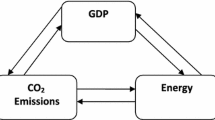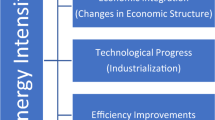Abstract
This paper aims to examine the relationship between energy consumption, information technology and communication (ICT), foreign direct investment (FDI), and economic growth using dynamic panel data of 13 MENA countries over the period 1990–2012. Recently developed tests for panel unit-root and co-integration tests are applied, in order to test the Granger causality. Econometric analysis results indicate that there are a bidirectional relationship between energy consumption and economic growth which is also known as the feedback hypothesis, but, there is a bidirectional relationship from ICT to economic growth in both the short run and the long run. However, the results support the existence of a unidirectional causality from economic growth to FDI. This study shows the importance of energy consumption and ITC in determining economic growth.
Similar content being viewed by others
References
Altinay, G., & Karagol, E. (2004). Structural break, unit root and causality between energy consumption and GDP in Turkey. Energy Economics, 26, 985–994.
Ang, J. (2008). Economic development, pollutant emissions and energy consumption in Malaysia. Journal of Policy Modeling, 30, 271–278.
Anwar, S., & Nguyen, L. P. (2010). Foreign direct investment and economic growth in Vietnam. Asia Pacific Business Review , 16, 83–202.
Apergis, N., & Payne, J. E. (2009). CO2 emissions, energy usage, and output in Central America. Energy Policy, 37, 3282–3286.
Apergis, N., & Payne, J. E. (2011). A dynamic panel study of economic development and the electricity consumption-growth nexus. Energy Economics, 33(5), 770–781.
Asafu-Adjaye, J. (2000). The relationship between elasticity consumption, electricity prices and economics growth: time series evidence from Asian developing countries. Energy Economics, 2, 615–625.
Barratt, R. S. (2006). Meeting lifelong learning needs by distance teaching—clean technology. Journal of Cleaner Production , 14, 906–915.
Belloumi, M. (2009). Energy consumption and GDP in Tunisia: cointegration and causality analysis. Energy Policy, 37, 2745–2753.
Borensztein, E., De Gregorio, J., & Lee, J.-W. (1998). How does foreign direct investment affect economic growth? Journal of International Economics, 45(1), 115–135.
Chakraborty, C., & Nandi, B. (2003). Privatization, telecommunications and growth in selected Asian countries: An econometric analysis. Communications and Strategies, 52(4), 31–47.
Chen, S. T., Kuo, H. I., & Chen, C. (2007). The relationship between GDP and electricity consumption in 10 Asian countries. Energy Policy, 35, 2611–2621.
Cheng, B. S., & Lai, T. W. (1997). An investigation of co-integration and causality between energy consumption and economic activity in Taiwan. Energy Economics, 19, 435–444.
Ewing, B.-T., Sari, R., & Soytas, U. (2007). Disaggregate energy consumption and industrial output in the United States. Energy Policy, 35, 1274–1281.
Ghosh, S. (2010). Examining carbon emissions-economic growth nexus for India: a multivariate cointegration approach. Energy Policy, 38, 2613–3130.
Hsiao, C., & Shen, Y. (2003). Foreign direct investment and economic growth: the importance of institutions and urbanization*. Economic Development and Cultural Change, 51(4), 883–896.
Hwang, D., & Gum, B. (1992). The causal relationship between energy and GNP: the case of Taiwan. Journal of Energy Development, 16, 219–226.
Jipp, A. (1963). Wealth of nations and telephone density. Telecommunication Journal, 30, 199–201.
Kao, C. (1999). Spurious regression and residual-based tests for cointegration in panel data. Journal of Econometrics, 90(1), 1–44.
Kraft, J., & Kraft, A. (1978). On the relationship between energy and GNP. Journal of Energy and Development , 3, 401–403.
Kundan, P., & Qingliang, G. (2010). A time series analysis of foreign direct investment and economic growth: a case study of Nepal. International Journal of Business Management , 5(2), 144–148.
Lam, P. L., & Shiu, A. (2010). Economic growth, telecommunications development and productivity growth of the telecommunications sector: Evidence around the world. Telecommunications Policy, 34(4), 185–199.
Lee, J. W. (2013). The contribution of foreign direct investment to clean energy use, carbon emissions and economic growth. Energy Policy, 55, 483–489.
Mahadevan, R., & Asafu-Adjaye, J. (2007). Energy consumption, economic growth and prices: a reassessment using panel VECM for developed and developing countries. Energy Policy, 35, 2481–2490.
Masih, A. M., & Masih, R. (1996). Energy consumption, real income and temporal causality: results from a multi-country study based on cointegration and error-correction modelling techniques. Energy economics, 18(3), 165–183.
Menyah, K., & Wolde-Rufael, Y. (2010). Energy consumption, pollutant emissions and economic growth in South Africa. Energy Economics, 32, 1374–1382.
Mielnik, O., & Goldemberg, J. (2000). Converging to a common pattern of energy use in developing and industrialized countries’. Energy Policy, 28, 503–508.
Ozturk, I., & Acaravci, A. (2010). Energy consumption and CO2 emissions economic growth in Turkey. Renewable and Sustainable Energy Reviews, 14(9), 3220–3225.
Pao, H. T. (2009). Forecast of electricity consumption and economic growth in Taiwan by state space modeling. Energy, 34, 1779–1791.
Pradhan, R. P. (2010). Energy consumption–growth nexus in SAARC countries: using cointegration and error correction model. Modern Applied Science, 4(4), 74–90.
Sari, R., Ewing, B. T., & Soytas, U. (2008). The relationship between disaggregate energy consumption and industrial production in the United States: An ARDL approach. Energy Economics 30, 2302–2313.
Saunders, R. J., Warford, J. J., Wellenius, B. (1983). Telecommunications and economic development. Baltimore and London: The Johns Hopkins University Press.
Shahbaz, M., Zeshan, M., & Afza, T. (2012). Is energy consumption effective to spur economic growth in Pakistan? New evidence from bounds test to level relationships and Granger causality tests. Economic Modelling, 29, 2310–2319.
Sharma, S. S. (2010). The relationship between energy and economic growth: empirical evidence from 66 countries. Applied Energy, 87, 3565–3574.
Shen, K., & Geng, Q. (2001). Foreign direct investment, technology spillover and endogenous economic growth [J]. Social Sciences in China, 5, 82–94.
Stern, D. I. (1993). Energy growth in the USA: a multivariate approach. Energy Economics, 15, 137–150.
Toffel, M. W., & Horvath, A. (2004). Environmental implications of wireless technologies: news delivery and business meetings. Environmental Science and Technology, 38, 2961–2970.
Yang, H. Y. (2000). A note on the causal relationship between energy and GDP in Taiwan. Energy economics, 22(3), 309–317.
Acknowledgment
The valuable comments from the editor and two anonymous referees have greatly helped improve the exposition of this paper.
Author information
Authors and Affiliations
Corresponding author
Rights and permissions
About this article
Cite this article
Saidi, K., Mbarek, M.B. & Amamri, M. Causal Dynamics between Energy Consumption, ICT, FDI, and Economic Growth: Case Study of 13 MENA Countries. J Knowl Econ 9, 228–238 (2018). https://doi.org/10.1007/s13132-015-0337-5
Received:
Accepted:
Published:
Issue Date:
DOI: https://doi.org/10.1007/s13132-015-0337-5




